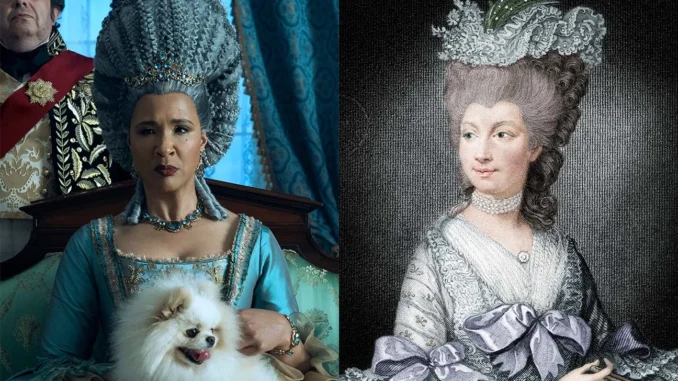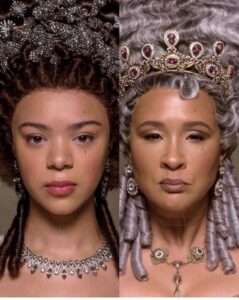
The success of the hit ‘Bridgerton’ prequel series has renewed interest in the real-life British royal.
If you’ve become enamored with the love story at the center of Netflix’s Queen Charlotte: A Bridgerton Story, you’ve likely questioned just how much of the period drama is based in fact versus the fantastical mind of creator Shonda Rhimes, given the opening disclaimer from Lady Whistledown that the series “is not a historical lesson” but rather “fiction inspired by fact.” While there’s no denying the masterful storytelling of Rhimes — the six-episode Bridgerton prequel was a runaway No. 1 among all titles on Netflix in its first week — the real-life story of the 18th century British royal provided great source material.
Queen Charlotte, née Sophia Charlotte of Mecklenburg-Strelitz, was born on May 18, 1744, in Mirow, a small town in north-eastern Germany. She was the daughter of Duke Charles Louis Frederick of Mecklenburg-Strelitz and Princess Elizabeth Albertina of Saxe-Hildburghausen, and at the age of 17 she did in fact marry King George III, heir to the British Monarchy.
According to Historic Royal Palaces, Charlotte “was “well enough” educated and spoke French, and she excelled in music, while Royal Collection Trust notes she was “a protestant with a good character.” Her personality was characterized as “sweet and good-humored, with a “lively but equal temper.” Charlotte died at Dutch House in Surrey, which is now known as Kew Palace, on Nov. 17, 1818, at the age of 74, and the true details of her life are as fascinating as the hit series she inspired. Here’s what we know about Britain’s longest-serving queen consort.

The Question of Moor Blood
While in the series, Charlotte is portrayed by biracial Indian actresses Ria Amarteifio and Golda Rosheuvel, historians generally agree that there’s no conclusive evidence of Charlotte’s rumored African ancestry. In a PBS Frontline article titled “The Blurred Racial Lines of Famous Families,” Charlotte is described as “directly descended from Margarita de Castro y Sousa, a Black branch of the Portuguese royal house,” noting “at least 492 lines of descent can be traced from Queen Charlotte through her triple ancestry from Margarita de Castro y Sousa to Martin Alfonso de Sousa Chichorro, the illegitimate son of King Alfonso of Portugal and his Moorish mistress, Oruana/Madragana.” This explains the scene in Queen Charlotte when King George III’s mother Princess Augusta says to one of the members of Parliament, “You did not say she would be that brown,” to which he responded, “I did say she had Moor blood.”
However, Nylah Burton, in an article on Vox, points out, “There are almost no records of anyone explicitly saying that Charlotte, born into the royal family of the northern German duchy of Mecklenburg-Strelitz, had Black parents, Black siblings, Black cousins or Black ancestors on either side.”
What does exist are conflicting portraits of Charlotte, some depicting her as having more European features and fair skin, others showing a darker complexion with a fuller nose and mouth. Queen Charlotte attempts to address this discrepancy in a scene in which Charlotte tells the artist painting her that her skin is too light and he should paint it darker “as it actually is.” However, Princess Augusta intervenes, directing him to “Paint her skin lighter. Pale,” adding, “His Majesty wants her to glow.”
According to Frontline, Sir Allan Ramsay was responsible for the majority of Queen Charlotte’s paintings and his representations were the most African in nature, which may be a biproduct of his anti-slavery ideology. Still, as Burton explains, “King Alphonso I was born in 1109 or 1111, and Queen Charlotte was born in 1744. That’s more than 600 years of distance between Queen Charlotte and her rumored African ancestor Madragana — who cannot conclusively be proven to be Black or related to Queen Charlotte.”
Her Marriage to King George III
George and Charlotte met for the first time on their wedding day on Sept. 8, 1761. George became king at 22 years old after his grandfather, King George II, died unexpectedly on October. 25, 1760, and his unmarried status became a “matter of national alarm,” National Geographic states. George’s father, Frederick, Prince of Wales, died from a pulmonary embolism in 1751.
Charlotte married George at the Chapel Royal in St James’s Palace just six hours after she arrived in England, and at the time she spoke no English. Their Coronation took place two weeks after their wedding on Sept. 22, 1761.
